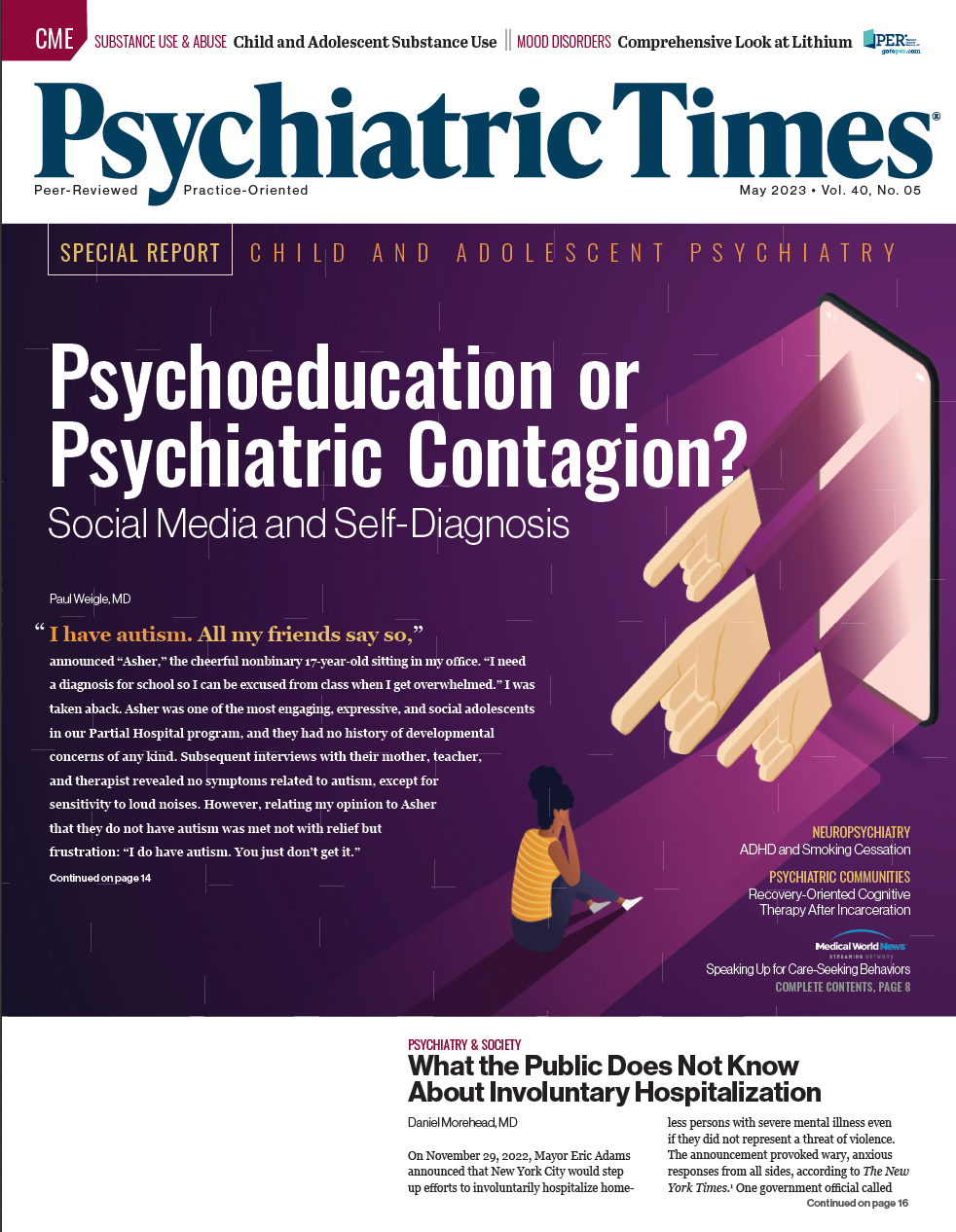Publication
Article
Psychiatric Times
What the Public Does Not Know About Involuntary Hospitalization
Author(s):
An expert discusses the reality of and the true role of psychiatrists in involuntary hospitalization.
catinsyrup_AdobeStock

On November 29, 2022, Mayor Eric Adams announced that New York City would step up efforts to involuntarily hospitalize homeless persons with severe mental illness even if they did not represent a threat of violence. The announcement provoked wary, anxious responses from all sides, according to The New York Times.1
One government official called the effort “deeply problematic” while others predicted legal challenges to the policy.1 Questions were immediately raised about exactly how the policy would be applied and whether the police were the best positioned group to apply it.
The mayor noted that there were hundreds of individuals living in public places who are “in urgent need of treatment and often refuse it” and that the city would “make every effort to assist those who are suffering from mental illness.” He confidently predicted, “We will find a bed for everyone” in need of hospitalization.1
Several public advocates were less confident. “The mayor talked about a ‘trauma-informed approach,’ but coercion is itself traumatic,” said one. Another said, “Instead of using the least restrictive approach, we are defaulting to an extreme that takes away basic human rights.” But most were cautious, recognizing both that the policy was “well intentioned” and that it was unlikely to be successful because of the severe undersupply of inpatient and outpatient mental health care.1
Earlier in fall 2022, California Governor Gavin Newsom signed a new law strengthening involuntary treatment in that state. According to The Associated Press, Newsom signed the bill despite the objections of the American Civil Liberties Union, Human Rights Watch, Disability Rights California, and “numerous other organizations.”2
Yet his action appears to be part of a gradual nationwide move toward legally mandated treatment of severe mental illness—a move that revives fears of coercive, oppressive, and traumatizing responses to mental illness.2 For some advocates, the dark prospect of an era of reinstitutionalization looms, met with renewed calls for “housing not handcuffs.”3
Where Are the Psychiatrists?
There is 1 group missing from the range of mental health consumers, legal specialists, homelessness advocates, and social libertarians quoted in these stories: psychiatrists. Psychiatrists do not seem to have a prominent public place in these discussions.4
It is not difficult to imagine a reason for this: involuntary treatment raises the specter of coercive psychiatry and the image of the psychiatrist as a power-hungry sadist. It revives and reinforces the hoary impression that the psychiatrist is an enforcer of social control rather than a healer of the mind. This is an image that very few psychiatrists wish to revisit.
There are 2 images closely tied to antipsychiatric feelings in the public consciousness: electroconvulsive therapy (ECT)5 and involuntary treatment.6 ECT continues to linger in the public mind as a barbaric and painful intervention that is more like a form of torture than a treatment. Few in the public realize that ECT is by far the most effective and well-proven treatment for life-threatening depression as well as other severe psychiatric crises.
Involuntary hospitalization, on the other hand, conjures up images of “the men in white coats” who show up to deprive those with mental illness of their freedoms without a word, slamming them in the van and driving off to the mental hospital without a hint of due process. Involuntary treatment, in the inaccurate images of public impression, lowers the person with mental illness to the status of a nonperson, a noncitizen without legal or even human rights.
It paints the psychiatrist as a harsh, uncaring instrument of an oppressive social order, someone, in fact, who only misuses the powers of a doctor for the sake of power and personal gain. And here, just as with ECT, the public impression is wrong.
What the Public Does Not Know
Involuntary treatment is common in all medical care. Involuntary care is not unique to psychiatry. In contrast to public impressions, involuntary treatment is a staple of all medical care for severe and life-threatening conditions. Consider, for instance, an unconscious victim of a car accident who is severely injured. Do we wait on treatment? Do we wonder if the person really wants treatment? Of course not.
Medical professionals simply proceed with the type of treatment that most individuals would choose in such a situation. Doctors and nurses opt to intervene to preserve life and restore health as much as they are able. As the injured individual returns to normal consciousness, they can decide for themselves whether to accept or reject further treatment.
Or take a slightly more complex case. A hospital patient with delirium believes that she is in a noisy dance club and insists on going home. Do we let her? Of course not.
Hospital staff will detain her for treatment, restraining her by tying her to the bed with soft restraints if necessary. I would wager, in fact, that there are hospital patients restrained to their beds in every hospital in this country right now. When they have returned to their normal mental state (or if family takes responsibility for their care), they can leave the hospital and return home at will.
The ethics of involuntary treatment are the same for psychiatry as for other medical specialties. The ethical principal is the same for psychiatry as for other branches of medicine: individuals with severe and life-threatening illnesses can refuse treatment, but only if they are in their normal state of mind to do so.
They can refuse if and only if they are able to think through and implement the decisions they would make when in their healthy state of mind. Otherwise, family, medical professionals, or other legally designated individuals must make the decision on the patient’s behalf. A patient with life-threatening cancer can refuse treatment if they understand the nature and consequences of their decision.
Obviously, there is an additional wrinkle associated with psychiatry: what about individuals with long-term medical illnesses that partially impair their decision-making ability? To be specific, those with psychotic illnesses may deal with the influence of unreal beliefs (delusions) or impaired cognition that profoundly affect their decision making. At the same time, they may retain some ability to reason about the consequences of their decisions and some ability to carry them out. Should individuals in this position be allowed to refuse treatment?
To be honest, our society does not know and our research base is grossly inadequate.7 As a result, our culture is profoundly ambivalent about this question. Although there is a definite ethical line that sets the boundaries for involuntary treatment, that line is broad and blurry. Many individuals with chronic mental illness find themselves astride the line in a decidedly uncomfortable position.
Psychiatrists do not force anyone to do anything. In the end, what psychiatrists believe about involuntary treatment is not decisive. Psychiatrists do not decide whether to compel individuals to accept psychiatric treatment. Psychiatrists do not have the ability to lock individuals up or inject them with medications against their will. Only the state has the power to force individuals to do things against their will.
At most, a psychiatrist can do what other medical professionals do: temporarily interpret laws for involuntary treatment until a judge can rule on the case. Ultimately it is the state that makes the decision about involuntary care and, in a democracy, the state is likely to follow the common understanding of the public.
Psychiatrists should only educate the public on involuntary commitment, not tell it what to do. Personally, I think psychiatrists are wise to stay out of the debate about specific involuntary commitment laws. We do not make the decisions about psychiatric care for the public as a whole or even our patients individually. The public does not see us as unbiased, science-based experts in regard to this question. It sees us as individuals who have a conflict of interest.
Rather than weigh in with an opinion on exactly how to make and implement our laws, I believe psychiatrists should try to educate the public (and government officials) about the nature of their choices. I do believe that the public—and even many government officials—are quite cloudy and conflicted about many of the decisions they are making.
Helping them understand their choices includes showing them that involuntary psychiatric treatment is not fundamentally different from other kinds of involuntary medical treatment and that psychiatrists, in this regard, are no different from any other kind of doctor.
Dr Morehead is a psychiatrist and director of training for the general psychiatry residency at Tufts Medical Center in Boston. He frequently speaks as an advocate for mental health and is author of Science Over Stigma: Education and Advocacy for Mental Health, published by the American Psychiatric Association. He can be reached at dmorehead@tuftsmedicalcenter.org.
References
1. Newman A, Fitzsimmons E. New York City to involuntarily remove mentally ill people from streets. New York Times. November 29, 2022. Accessed February 6, 2023. https://www.nytimes.com/2022/11/29/nyregion/nyc-mentally-ill-involuntary-custody.html
2. Har J, Beam A. California governor OKs mental health courts for homeless. Associated Press. September 14, 2022. Accessed February 6, 2023. https://apnews.com/article/health-california-san-francisco-gavin-newsom-mental-0e68288d97959f9ceeb5c5683afa092b
3. Harris L. And now they are coming for the unhoused: the long push to expand involuntary treatment in America. Mad in America. December 10, 2022. Accessed February 6, 2023. https://www.madinamerica.com/2022/12/unhoused-expand-involuntary-treatment/
4. Barry E. Behind New York City’s shift on mental health, a solitary quest. New York Times. December 11, 2022. Accessed February 6, 2023. https://www.nytimes.com/2022/12/11/health/fuller-torrey-psychosis-commitment.html
5. Jenkusky SM. The public perception of electroconvulsive therapy: a historic review. Jefferson Journal of Psychiatry. 1992;10(2).
6. Rissmiller DJ, Rissmiller JH. Evolution of the antipsychiatry movement into mental health consumerism. Psychiatr Serv. 2006;57(6):863-866.
7. Morris NP, Kleinman RA. Taking an evidence-based approach to involuntary psychiatric hospitalization. Psychiatr Serv. 2022;appips20220296.






